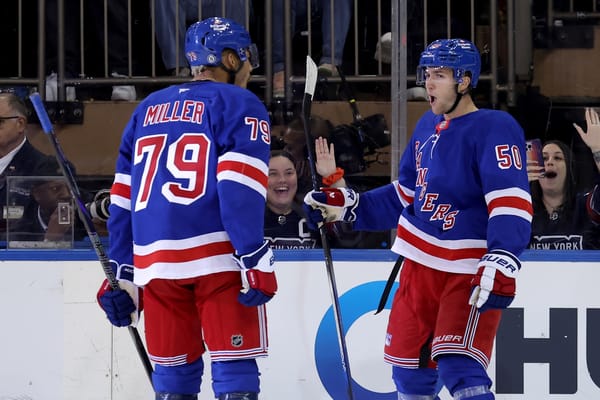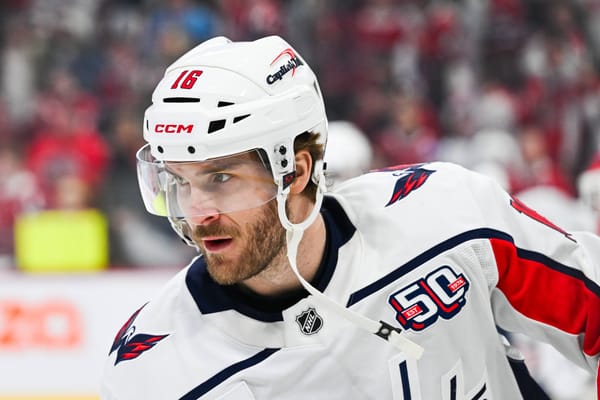Brett Howden Highlights the Rangers’ Bottom-Six Problems
As Tim Robinson told Chunky, “you need to figure out what you do!”
If the Rangers do miss the playoffs, as currently projected, then nobody outside of the unappeasable will be discouraged or heartbroken. A bit wistful? Perhaps. But by making it a close call in March, the Rangers have exceeded most expectations for this season. The trajectory of the franchise is inarguably heading upwards.
So when the team’s offseason officially begins, the question that President John Davidson and General Manager Jeff Gorton will have to answer won’t be, “What went wrong?” Instead, their initiative will be to build on what went right in 2019-2020 and fill in the gaps so that this team can climb a few more rungs up the ladder towards Stanley Cup contention.
There are certainly a number of areas where improvement is possible. Arguably none are more gaping than the team’s (lack of) forward depth. A spreadsheet isn’t necessary to reveal that the team’s top few forwards are going above and beyond in dragging the rest of the group to competitiveness in many games. It’s quite apparent to anyone in the arena or watching on TV.
But the data really does drive home how stark the divide is. Here are the Rangers’ top-twelve forwards (Brendan Smith excluded) ranked by Goals Above Replacement; a statistic that serves to estimate a player’s isolated contribution to his team’s performance this season. Please note that this data is as of March 2nd and therefore does not include Tuesday’s game against St. Louis.
For context, the Rangers’ top-six group ranks third in the NHL when compared to every other team’s top-six minute earners at forward. For the bottom-six? The Rangers’ group ranks 30th, with Detroit (-15.3) just barely edging them out for the last-place slot.
There’s plenty of blame to go around, but let’s focus on Brett Howden. He is not a teenager making a huge adjustment like Kakko, nor is he waiver fodder serving as a short-term placeholder like a few on the list (not to mention others like Brendan Smith and Micheal Haley). Most, if not all, were never intended to be, and will not be, on the forward depth chart next October.
Howden is nearly 22 years old and has 132 NHL games (plus five in the AHL) to his name. Even if he hasn’t quite reached the peak of his abilities, he should be a productive player to some degree by now. One could forgive if Howden was an incomplete player and it would also be tolerable if he was an inconsistent one. But you have to be showing something. An ability to contribute to the team in some facet of the game. A string of high-performance games that indicate an issue of consistency rather than upside.
In what ways Howden excelled this season?
Driving Play
Is Howden driving play for the Rangers? Not only is he not, but the ice is severely tilted the wrong way when he’s been on the ice for most of this season. Here are both Howden’s (red) and the Rangers’ (blue) cumulative averages for expected goals percentage at five-on-five as the season has progressed.
Not only is Howden performing well below the team average, but the gap between him and the team has grown over the season. The Rangers have been better as the season has progressed, but Howden has gotten worse, hovering below the 40-percent mark. Over the team’s last 20 games they have been expected to score 50.9-percent of the goals at five-on-five, but that number drops way down to 38.25-percent during Howden’s shifts specifically.
It’s not only that Howden isn’t driving play, but that you can’t parse the data and find any strong points. Ryan Strome’s overall impact on a team’s expected goal totals isn’t very good, but that’s largely because his poor defense negates a lot of what he does offensively. A coach can get the most out of Strome by leaning on his strengths and covering up his weaknesses. Give him strong defensive cover with Fast and Panarin. Put him out when the team is down a goal. Keep him away from the opposition’s top offensive players when you can. And so on.
Here’s a chart via Hockey Viz which separates Howden’s offensive and defensive impacts at five-on-five.
To simplify what’s being shown here, blue areas are low shot volume while red areas are high shot volume. Howden’s estimated offensive impact is that, assuming league-average shooting, his teams will score five-percent fewer goals compared to the average player. Defensively, his presence is estimated to result in seven-percent more goals against. These numbers are an estimated impact based on both of his seasons in the NHL.
Special Teams
Evaluating an individual’s special teams contributions can be difficult. For one, there’s an issue of sample. It can also be difficult to figure who on the ice is doing what and how much tactics influence decision making on the ice.
Nonetheless, the evidence isn’t pointing in Howden’s favor. He’s barely gotten any power play time; just 20:46 of icetime this season with the man advantage, which ranks 12th on the team. Last season he received somewhat of an opportunity and didn’t make much of it. He had just one primary assist in over 90 minutes of PP time and the team’s expected goals numbers were relatively low with him on the ice.
Maybe Howden could be a power play asset if he got an opportunity, but when would he ever get a chance to find out on the Rangers? Their power play has been one of the bright spots this season and it’s so stacked with talent that the likes of Buchnevich, Kakko, and Trouba have struggled to find time on the top unit. What opening does that leave for someone like Howden?
He has earned time on the penalty kill, and as the even-strength numbers might suggest, he hasn’t been very good. Evolving Hockey estimates that he’s been worth -1.4 goals on the penalty kill compared to a replacement-level player this season. His expected goal numbers are poor on the PK, though it’s fair to wonder how other players on the ice impact that. At absolute best, one could argue that the evidence is insufficient to definitively rule him a terrible penalty killer. There’s certainly nothing to indicate it’s been a positive, though.
Penalty Impact
One of the subtler parts of the game that has earned more attention in recent years is a player’s ability to draw penalties and avoid taking them. As poor as Kaapo Kakko’s season has been, his ability to draw penalties is a major bright spot. He’s drawn 15 minor penalties which isn’t surprising given his strength and his ability to hold the puck for long stretches. Meanwhile, Kakko has only taken seven penalties himself. That differential (+8) puts him 66th in the league among forwards.
Howden has taken 13 minors and has drawn nine. That’s hardly terrible. to compare, Ryan Strome has taken 24 and drawn seven. It’s certainly not good, though. He’s taking more penalties than he’s drawing, and one might wonder how much higher that differential would be if he was earning more minutes. Last season he drew eight and took seven. Certainly, this is not an area where he’s making a positive contribution.
Offensive Production
Has Howden produced offensively? He has nine goals and eight assists in 66 games. This is probably the best part of his game this season, and the underlying numbers indicate that it’s not inflated by a run of luck.
Relativity is key. Anthony Duclair has bounced around the NHL despite solid point totals. Trevor Lewis has carved out a long, successful career in Los Angeles despite barely getting on the scoresheet. The pertinent question is if Howden’s offense is good enough as a complement to the rest of his game.
It is possible for a player to outscore his problems. We’ve already discussed Strome in this regard. Phil Kessel has built a career as the platonic ideal for this phenotype. Patrik Laine, Nikita Gusev, and Mike Hoffman are other examples. Typically, these players are such high-end scorers that there’s not much they could do wrong to completely undermine that. Howden is clearly not producing like them.
It’s a lot more difficult for a bottom-six forward to fit into this group, though there are a few rare examples. Brett Connolly has built a career out of it in Washington and now Florida. Bryan Bickell won two Stanley Cups in Chicago as a point producer who didn’t contribute much. In cases like these, the players’ weaknesses are not as extreme as Howden’s are, and their point outputs are better than Howden’s is.
The best way to sum up Howden’s point production is by saying there are higher scoring players who haven’t stuck in the NHL.
What Does He Bring to the Table?
The problem with Howden is not simply that his overall impact has been negative, but that there aren’t any particular areas of his game that offer him a role on the team and a foundation to work off of. He’s an okay point producer for a bottom-six forward, and that’s the best of his performances. He’s not a possession driver. He’s a defensive liability. He’s not good enough to feature on the power play. Even faceoffs haven’t been great, with him winning 47.9% of them this season. What is his identity?
He’s been tried in different situations. He’s been given numerous linemates. He’s had his minutes decreased. He’s been shifted to the wing. Nothing has made a meaningful difference.
Does that mean he definitively will never carve out his niche and turn into a capable NHLer? Of course not. Development is finicky, and he wouldn’t be the first player who didn’t figure it out until he was 22, or 23, or even 24. It’s not as if he’s bereft of talent. He’s big. He’s got a good wrist shot. He’s competitive and battles around the net.
But the outlook certainly isn’t optimistic, and the Rangers are reaching a transition point. The team will not only be looking to make the playoffs next season, but to make some noise once they get there. That doesn’t mean they’re all in for a Cup, but they’re going to have to be more selective about which youngsters are given leniency in the name of development. They can’t throw away points in the standings for the sake of coddling a 22-year-old who’s shown no tangible progress over the course of 150-plus NHL games.
So what do you do with Howden? Do you trade him? Do you make an embarrassing but potentially earned demotion to the AHL and hope he that playing at a lower level allows him to develop his abilities? Either is option, and that would require a different type of discussion involving his trade value and the Rangers’ options at center.
What the team can’t do, however, is enter next September’s training camp with him penciled onto the roster. Next season will actually mean something, and to make anything of it they’re going to need legitimate NHLers in the bottom-six who are not only positive contributors overall, but who fill particular roles. Maybe Howden will have a strong training camp and earn his lineup spot early in the season by showing tangible progress in the regular season. If so, then great. Otherwise, the team better be ready to admit he just doesn’t have it, at least right now, and the groundwork will need to have already been laid to ensure someone who is capable will be there to take his place.




